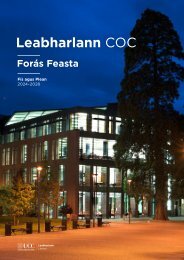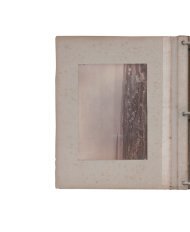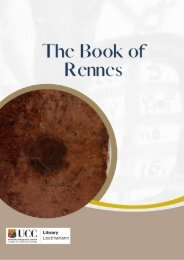Lead Toxicity in Mute Swans
LEAD TOXICITY IN MUTE SWANS Cygnus olor (Gmelin). By JOHN O'HALLORAN A thesis submitted to the National University of Ireland in candidature for the degree of Doctor of Philosophy September 1987
LEAD TOXICITY IN MUTE SWANS
Cygnus olor (Gmelin).
By
JOHN O'HALLORAN
A thesis submitted to the National University of Ireland
in candidature for the degree of Doctor of Philosophy
September 1987
Create successful ePaper yourself
Turn your PDF publications into a flip-book with our unique Google optimized e-Paper software.
Comp. Biochem. Physiol. Vol. 868, No. 4, pp. 701- 704, 1987<br />
Pr<strong>in</strong>ted <strong>in</strong> Great Brita<strong>in</strong><br />
0305-0491 /87 S3.00 + 0.00<br />
Pergamon Journals Ltd<br />
DETERMINATION OF HAEMOGLOBIN IN BIRDS<br />
BY A MODIFIED ALKALINE HAEMATIN<br />
(D-575) METHOD<br />
(Received 3 June 1986)<br />
Abstract-1. A recently published method for measur<strong>in</strong>g human haemoglob<strong>in</strong> based on alkal<strong>in</strong>e haemat<strong>in</strong><br />
(Zander et al. , Cl<strong>in</strong>. chem. Acta 136, 83- 93 , 1984) has been adopted for bird samples.<br />
2. The new method yields comparable haemoglob<strong>in</strong> values with that of a previously used alkal<strong>in</strong>e<br />
haemat<strong>in</strong> method.<br />
3. Levels of haemoglob<strong>in</strong> estimated us<strong>in</strong>g alkal<strong>in</strong>e haemat<strong>in</strong> were higher than for cyanhaemiglob<strong>in</strong>,<br />
the reference method for human haemoglob<strong>in</strong>. This difference is due to the loss of haemoglob<strong>in</strong> <strong>in</strong> the<br />
cyanhaemiglob<strong>in</strong> procedure due to <strong>in</strong>solubility.<br />
4. The values for haemoglob<strong>in</strong> found by the alkal<strong>in</strong>e haemat<strong>in</strong> method did not vary significantly<br />
between a range of bird species.<br />
5. The method overcomes some important deficiencies of the cyanhaemiglob<strong>in</strong> method, <strong>in</strong> particular,<br />
problems of turbidity and quality control assessment.<br />
INTRODUCTION<br />
Haematology plays an important diagnostic role <strong>in</strong><br />
human and veter<strong>in</strong>ary medic<strong>in</strong>e and modern haematological<br />
methods are now be<strong>in</strong>g <strong>in</strong>creas<strong>in</strong>gly used<br />
<strong>in</strong> avian research and wildlife <strong>in</strong>vestigations. The<br />
direct application of methods developed for mammalian<br />
studies is, however, problematical <strong>in</strong> birds due<br />
to the presence of red blood cell nuclei, <strong>in</strong> addition<br />
to other cell debris on haemolysis. This debris is liable<br />
to lead to substantial error due to turbidity of the<br />
specimen. The accuracy and precision of the various<br />
methods for estimat<strong>in</strong>g haemoglob<strong>in</strong> differs markedly<br />
(Van Assendelft, 1972; Rick, 1976; Bankowski, 1942).<br />
The spectrophotometric method us<strong>in</strong>g cyanbaemiglob<strong>in</strong><br />
has been the most widely accepted (Spaander,<br />
1964; Saundermann, 1956) and was recommended<br />
by the International Committee for Standardisation<br />
<strong>in</strong> Haematology (ICSH) <strong>in</strong> 1965 and <strong>in</strong> 1967. S<strong>in</strong>ce<br />
cyanhaemiglob<strong>in</strong> is considered the only stable derivative<br />
(Richterich, 1971) all other methods were<br />
rejected (Rick, 1976). Thus the cyanhaemiglob<strong>in</strong><br />
method is considered the reference method aga<strong>in</strong>st<br />
which all others must be tested.<br />
While the use of cyanhaemiglob<strong>in</strong> has many<br />
significant advantages it also has a number of<br />
deficiencies which were recently restated by Zander et<br />
al. ( 1984). These can be summarised as follows:<br />
(1) The cyanhaemiglob<strong>in</strong> reagent conta<strong>in</strong>s cyanide,<br />
is toxic and thus hazardous.<br />
(2) The reaction solution is light labile.<br />
(3) The concentration of the reaction components,<br />
especially that of cyanide and the buffer have to be<br />
carefully chosen and kept constant.<br />
(4) Standardization of the method is based on<br />
purified cyanhaemiglob<strong>in</strong> solutions, the quality of<br />
which is controlled only <strong>in</strong>directly by spectrophotometry.<br />
(5) The reaction times of the different haemoglob<strong>in</strong><br />
species and derivatives differ markedly.<br />
While the above disadvantages are important for<br />
mammalian studies their significance becomes even<br />
greater for animals with nucleated red blood cells.<br />
Thus the follow<strong>in</strong>g disadvantage can be added to the<br />
above:<br />
(6) The reaction end-product is turbid and requires<br />
centrifugation before read<strong>in</strong>g spectrophotometrically.<br />
With centrifugation, the supernatant becomes<br />
clear and a residue forms as a pellet at the<br />
bottom of the tube.<br />
A further disadvantage of the cyanhaemiglob<strong>in</strong><br />
method which is important for the field biologist is<br />
the fact that the reaction end-product is light labile<br />
which imposes time constra<strong>in</strong>ts on field biologists, <strong>in</strong><br />
remote areas wish<strong>in</strong>g to study blood parameters.<br />
Information on the precise haemoglob<strong>in</strong> levels <strong>in</strong><br />
healthy birds and birds contam<strong>in</strong>ated by environmental<br />
tox<strong>in</strong>s, such as lead, is needed but to what<br />
extent cyanhaemiglob<strong>in</strong> may assay actual avian<br />
haemoglob<strong>in</strong> is not known (Archer, 1977).<br />
This <strong>in</strong>vestigation therefore exam<strong>in</strong>ed a new<br />
method described for estimat<strong>in</strong>g haemoglob<strong>in</strong> <strong>in</strong> humans<br />
(Zander et al. , 1984) to see if current difficulties<br />
<strong>in</strong> estimat<strong>in</strong>g non-mammalian haemoglob<strong>in</strong> could be<br />
resolved. This method is based on the conversion of<br />
all haeme, haemoglob<strong>in</strong>, and haemiglob<strong>in</strong> species<br />
<strong>in</strong>to stable end-products by an alkal<strong>in</strong>e solution of a<br />
non-ionic detergent. The reaction product, designated<br />
as alkal<strong>in</strong>e haemat<strong>in</strong> D-575, is extremely stable<br />
and shows an absorption peak at 575 nm. This paper<br />
describes the results obta<strong>in</strong>ed from us<strong>in</strong>g this<br />
modified alkal<strong>in</strong>e haemat<strong>in</strong> method for avian blood.<br />
These results were also compared with the reference<br />
method (cyanhaemiglob<strong>in</strong>), and a previously used<br />
alkal<strong>in</strong>e haemat<strong>in</strong> method of Bell et al. (1965).<br />
- 8 -
















